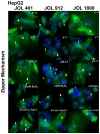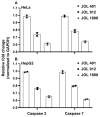Intracellular Survival and Pathogenicity Modulation of Salmonella Lon, CpxR, and RfaL Mutants Used as Live Bacterial Vectors under Abiotic Stress, Unveiling the Link between Stress Response and Virulence in Epithelial Cells
- PMID: 39201742
- PMCID: PMC11354574
- DOI: 10.3390/ijms25169056
Intracellular Survival and Pathogenicity Modulation of Salmonella Lon, CpxR, and RfaL Mutants Used as Live Bacterial Vectors under Abiotic Stress, Unveiling the Link between Stress Response and Virulence in Epithelial Cells
Abstract
In the current study, two Salmonella Typhimurium strains, JOL 912 and JOL 1800, were engineered from the wild-type JOL 401 strain through in-frame deletions of the lon and cpxR genes, with JOL 1800 also lacking rfaL. These deletions significantly attenuated the strains, impairing their intracellular survival and creating unique immunological profiles. This study investigates the response of these strains to various abiotic stress conditions commonly experienced in vivo, including temperature, acidity, osmotic, and oxidative stress. Notably, cold stress induced a non-significant trend towards increased invasion by Salmonella compared to other stressors. Despite the observed attenuation, no significant alterations in entry mechanisms (trigger vs. zipper) were noted between these strains, although variations were evident depending on the host cell type. Both strains effectively localized within the cytoplasm, demonstrating their ability to invade and interact with the intracellular environment. Immunologically, JOL 912 elicited a robust response, marked by substantial activation of nuclear factor kappa B (NF-kB), and chemokines, interleukin 8 (CXCL 8) and interleukin 10 (CXCL 10), comparable to the wild-type JOL 401 (over a fourfold increase compared to JOL 1800). In contrast, JOL 1800 exhibited a minimal immune response. Additionally, these attenuations influenced the expression of cyclins D1 and B1 and caspases 3 and 7, indicating cell cycle arrest at the G2/M phase and promotion of the G0/G1 to S phase transition, alongside apoptosis in infected cells. These findings provide valuable insights into the mechanisms governing the association, internalization, and survival of Salmonella mutants, enhancing our understanding of their regulatory effects on host cell physiology.
Keywords: NF-kB; Salmonella Typhimurium; abiotic stress; cell cycle arrest; chemokines; intracellular survival.
Conflict of interest statement
The authors declare no conflicts of interest.
Figures









Similar articles
-
Deletion of the lon gene augments expression of Salmonella Pathogenicity Island (SPI)-1 and metal ion uptake genes leading to the accumulation of bactericidal hydroxyl radicals and host pro-inflammatory cytokine-mediated rapid intracellular clearance.Gut Microbes. 2020 Nov 1;11(6):1695-1712. doi: 10.1080/19490976.2020.1777923. Epub 2020 Jun 21. Gut Microbes. 2020. PMID: 32567462 Free PMC article.
-
LoiA directly represses lon gene expression to activate the expression of Salmonella pathogenicity island-1 genes.Res Microbiol. 2019 Apr-May;170(3):131-137. doi: 10.1016/j.resmic.2019.01.001. Epub 2019 Jan 12. Res Microbiol. 2019. PMID: 30648612
-
Coordinated interaction between Lon protease and catalase-peroxidase regulates virulence and oxidative stress management during Salmonellosis.Gut Microbes. 2022 Jan-Dec;14(1):2064705. doi: 10.1080/19490976.2022.2064705. Gut Microbes. 2022. PMID: 35438052 Free PMC article.
-
A comprehensive study of the contribution of Salmonella enterica serovar Typhimurium SPI2 effectors to bacterial colonization, survival, and replication in typhoid fever, macrophage, and epithelial cell infection models.Virulence. 2011 May-Jun;2(3):208-16. doi: 10.4161/viru.2.3.15894. Epub 2011 May 1. Virulence. 2011. PMID: 21540636 Free PMC article.
-
Evolution of Salmonella-Host Cell Interactions through a Dynamic Bacterial Genome.Front Cell Infect Microbiol. 2017 Sep 29;7:428. doi: 10.3389/fcimb.2017.00428. eCollection 2017. Front Cell Infect Microbiol. 2017. PMID: 29034217 Free PMC article. Review.
Cited by
-
The mcpC mutant of Salmonella enteritidis exhibits attenuation and confers both immunogenicity and protective efficacy in mice.Front Microbiol. 2025 Feb 10;16:1548920. doi: 10.3389/fmicb.2025.1548920. eCollection 2025. Front Microbiol. 2025. PMID: 39996075 Free PMC article.
References
-
- Sereme Y., Schrimp C., Faury H., Agapoff M., Lefebvre-Wloszczowski E., Chang Marchand Y., Ageron-Ardila E., Panafieu E., Blec F., Coureuil M., et al. A live attenuated vaccine to prevent severe neonatal Escherichia coli K1 infections. Nat. Commun. 2024;15:3021. doi: 10.1038/s41467-024-46775-x. - DOI - PMC - PubMed
-
- Hochnadel I., Hoenicke L., Petriv N., Neubert L., Reinhard E., Hirsch T., Alfonso J.C.L., Suo H., Longerich T., Geffers R., et al. Safety and efficacy of prophylactic and therapeutic vaccine based on live-attenuated Listeria monocytogenes in hepatobiliary cancers. Oncogene. 2022;41:2039–2053. doi: 10.1038/s41388-022-02222-z. - DOI - PMC - PubMed
MeSH terms
Substances
LinkOut - more resources
Full Text Sources

